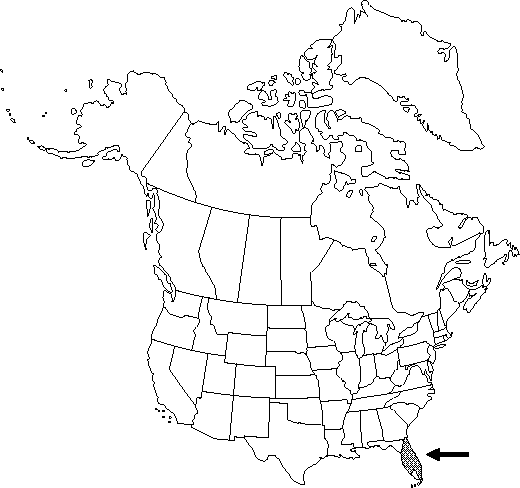Difference between revisions of "Clematis baldwinii"
Fl. N. Amer. 1: 8. 1838.
FNA>Volume Importer |
imported>Volume Importer |
||
| (7 intermediate revisions by 2 users not shown) | |||
| Line 16: | Line 16: | ||
|name=Clematis baldwinii var. latiuscula | |name=Clematis baldwinii var. latiuscula | ||
|authority=R. W. Long | |authority=R. W. Long | ||
| − | }}{{Treatment/ID/Synonym | + | |rank=variety |
| + | }} {{Treatment/ID/Synonym | ||
|name=Viorna baldwinii | |name=Viorna baldwinii | ||
| − | |authority= | + | |authority= |
| + | |rank=species | ||
}} | }} | ||
|hierarchy=Ranunculaceae;Clematis;Clematis subg. Viorna;Clematis baldwinii | |hierarchy=Ranunculaceae;Clematis;Clematis subg. Viorna;Clematis baldwinii | ||
| Line 27: | Line 29: | ||
}}<!-- | }}<!-- | ||
| − | --><span class="statement" id="st- | + | --><span class="statement" id="st-undefined" data-properties=""><b>Stems </b>erect, 2-6 dm, nearly glabrous to moderately pilose. <b>Leaves</b> usually simple. <b>Leaf</b> blade unlobed or 2-3-lobed, occasionally divided into 3-5 leaflets; leaflet blades or lobes linear to narrowly elliptic-lanceolate, or unlobed leaf blades elliptic to ovate, 1.5-10 × 0.2-2.5(-3.5) cm, thin, not prominently reticulate; surfaces glabrous, not glaucous. <b>Inflorescences</b> terminal, flowers solitary; bracts absent or sometimes distal pair of leaves smaller, bractlike. <b>Flowers</b> narrowly bell-shaped; sepals uniformly violet-blue, oblong-lanceolate, 2-5.5 cm, margins narrowly expanded distally to ca. 1 mm wide, thin, crispate, proximally tomentose, glabrous where expanded, distally ± tomentose, tips acuminate, spreading to recurved, abaxially glabrous. <b>Achenes</b>: bodies long-pubescent; beak 6-10 cm, plumose. <b>2n</b> = 16.</span><!-- |
-->{{Treatment/Body | -->{{Treatment/Body | ||
| Line 34: | Line 36: | ||
|elevation=0-50 m | |elevation=0-50 m | ||
|distribution=Fla. | |distribution=Fla. | ||
| − | |discussion=<p>The long peduncles (10-30 cm) elevating the flowers well above the leaves are unique to Clematis baldwinii among the simple-leaved species of Clematis subg. Viorna in the flora. Broad-leaved, large-flowered plants have been segregated as C. baldwinii var. latiuscula, but many intermediates connect the extremes, and flower size is not well correlated with leaf shape. As noted by C. S. Keener (1975), leaf shape appears to be uncorrelated with distribution; collections from a single population often include broad- and narrow-leaved plants.</p> | + | |discussion=<p>The long peduncles (10-30 cm) elevating the flowers well above the leaves are unique to <i>Clematis baldwinii</i> among the simple-leaved species of <i>Clematis </i>subg.<i> Viorna</i> in the flora. Broad-leaved, large-flowered plants have been segregated as <i>C. baldwinii</i> var. latiuscula, but many intermediates connect the extremes, and flower size is not well correlated with leaf shape. As noted by C. S. Keener (1975), leaf shape appears to be uncorrelated with distribution; collections from a single population often include broad- and narrow-leaved plants.</p> |
|tables= | |tables= | ||
|references= | |references= | ||
| Line 43: | Line 45: | ||
-->{{#Taxon: | -->{{#Taxon: | ||
name=Clematis baldwinii | name=Clematis baldwinii | ||
| − | |||
|authority=Torrey & A. Gray | |authority=Torrey & A. Gray | ||
|rank=species | |rank=species | ||
| Line 58: | Line 59: | ||
|publication year=1838 | |publication year=1838 | ||
|special status=Endemic | |special status=Endemic | ||
| − | |source xml=https:// | + | |source xml=https://bitbucket.org/aafc-mbb/fna-data-curation/src/2e0870ddd59836b60bcf96646a41e87ea5a5943a/coarse_grained_fna_xml/V3/V3_163.xml |
|genus=Clematis | |genus=Clematis | ||
|subgenus=Clematis subg. Viorna | |subgenus=Clematis subg. Viorna | ||
|species=Clematis baldwinii | |species=Clematis baldwinii | ||
| − | |||
| − | |||
| − | |||
| − | |||
| − | |||
| − | |||
| − | |||
| − | |||
| − | |||
| − | |||
| − | |||
| − | |||
| − | |||
| − | |||
| − | |||
| − | |||
| − | |||
| − | |||
| − | |||
| − | |||
| − | |||
| − | |||
| − | |||
| − | |||
| − | |||
| − | |||
| − | |||
| − | |||
| − | |||
| − | |||
| − | |||
| − | |||
| − | |||
| − | |||
}}<!-- | }}<!-- | ||
-->[[Category:Treatment]][[Category:Clematis subg. Viorna]] | -->[[Category:Treatment]][[Category:Clematis subg. Viorna]] | ||
Latest revision as of 21:46, 5 November 2020
Stems erect, 2-6 dm, nearly glabrous to moderately pilose. Leaves usually simple. Leaf blade unlobed or 2-3-lobed, occasionally divided into 3-5 leaflets; leaflet blades or lobes linear to narrowly elliptic-lanceolate, or unlobed leaf blades elliptic to ovate, 1.5-10 × 0.2-2.5(-3.5) cm, thin, not prominently reticulate; surfaces glabrous, not glaucous. Inflorescences terminal, flowers solitary; bracts absent or sometimes distal pair of leaves smaller, bractlike. Flowers narrowly bell-shaped; sepals uniformly violet-blue, oblong-lanceolate, 2-5.5 cm, margins narrowly expanded distally to ca. 1 mm wide, thin, crispate, proximally tomentose, glabrous where expanded, distally ± tomentose, tips acuminate, spreading to recurved, abaxially glabrous. Achenes: bodies long-pubescent; beak 6-10 cm, plumose. 2n = 16.
Phenology: Flowering all year.
Habitat: Sandy, flat pine woods
Elevation: 0-50 m
Discussion
The long peduncles (10-30 cm) elevating the flowers well above the leaves are unique to Clematis baldwinii among the simple-leaved species of Clematis subg. Viorna in the flora. Broad-leaved, large-flowered plants have been segregated as C. baldwinii var. latiuscula, but many intermediates connect the extremes, and flower size is not well correlated with leaf shape. As noted by C. S. Keener (1975), leaf shape appears to be uncorrelated with distribution; collections from a single population often include broad- and narrow-leaved plants.
Selected References
None.
